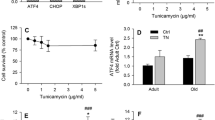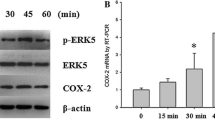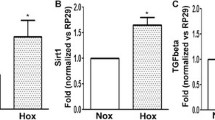Summary
The osteonectin/SPARC gene has been shown to possess motifs for a heat shock element and metal responsiveness. Also, the expression of the protein has been associated with culture stress in endothelial cells. In the present study, osteoligament (OL) cells derived from the patellar ligament were subjected to diverse forms of stress that included (a) exposure to sodium arsenite, (b) heat shock, (c) cadmium ion, and (d) the amino acid analog, AZC. Osteonectin/SPARC levels in OL cells were determined by Western blot analyses, and immunoprecipitation using antiosteonectin antibodies. Expression of osteonectin/SPARC mRNA was determined by Northern analysis using a 1.5 kb EcoRI restriction fragment of bovine osteonectin cDNA. These studies reveal that osteonectin/SPARC is produced following diverse forms of stress, however, the levels are lower than observed in unchallenged OL cells. In all instances, the mRNA levels were comparable to control cells. These studies indicate that expression of osteonectin/SPARC mRNA is tightly controlled in OL cells and that the protein may be regulated at the level of protein translation.
Similar content being viewed by others
References
Termine JD, Kleinman HK, Whitson SW, Conn KM, McGarvey ML, Martin GR (1981) Osteonectin, a bone-specific protein linking mineral to collagen. Cell 26:99–105
Fisher LW, Hawkin GR, Tuross N, Termine JD (1987) Purification and partial characterization of small proteoglycans I and II, bone sialoproteins I and II, and osteonectin from the mineral compartment of developing human bone. J Biol Chem 262:9702–9708
Bianco P., Hayashi Y, Silvestrini G, Termine JD, Bonucci E (1985) Osteonectin and GLA-protein in calf bone: ultrastructural immunohistochemical localization using the protein A-gold method. Calcif Tissue Int 37:684–686
Otsuka K, Yao K-L, Wasi S, Tung PS, Aubin JE, Sodek J, Termine JD (1984) Biosynthesis of osteonectin by fetal porcine calvarial cells in vitro. J Biol Chem 259:9805–9812
Wasi S, Otsuka K, Yao K-L, Tung PS, Aubin JE, Sodek J, Termine JD (1984) An osteonectin-like protein in porcine periodontal ligament and its synthesis by periodontal ligament fibroblasts. Biochem Cell Biol 62:470–478
Mason IJ, Taylor A, Williams JG, Sage H, Hogan B (1986) Evidence from molecular cloning that SPARC a major product of mouse embryo parietal endoderm, is related to an endothelial cell “culture shock” glycoprotein. EMBO J 5: 1465–1472
Stenner DD, Tracy RP, Riggs BL, Mann KG (1986) Human platelets contain and secrete osteonectin, a major protein of mineralized bone. Proc Natl Acad Sci USA 83:6892–6896
Young MF, Bolander ME, Day AA, Ramis CI, Robey PG, Yamada Y, Termine JD (1986) Osteonectin mRNA: distribution in normal and transformed cells. Nucleic Acids Res 14:4483–4497
Zung P, Domenicucci C, Wasi S, Kuwata F, Sodek J (1986) Osteonectin is a minor component of mineralized connective tissues in rat. Biochem Cell Biol 64:356–362
Bolander ME, Young MF, Fisher LW, Yamada Y, Termine JD (1988) Osteonectin cDNA sequence reveals potential binding regions for calcium and hydroxyapatite and shows homologies with both a basement membrane protein (SPARC) and a serine proteinase inhibitor (ovomucoid). Proc Natl Acad Sci USA 85:2919–2923
Sage H, Pritzl P, Bornstein P (1981) Secretory phenotypes of endothelial cells in culture: a comparison of aortic, venous, capillary, and corneal endothelium. Arteriosclerosis 1:427–442
Dziadek M, Paulsson M, Aumailley M, Timpl R (1986) Purification and tissue distribution of a small protein (BM-40) extracted from a basement membrane tumor. Eur J Biochem 161:455–464
Mann K, Deutzmann R, Paulsson M, Timpl R (1987) Solubilization of protein BM-40 from a basement membrane tumor with chelating agents: evidence for its identity with osteonectin and SPARC. FEBS Lett 218:167–172
Sage H, Johnson C, Bornstein P (1984) Characterization of a novel albumin-binding glycoprotein secreted by endothelial cells in culture. J Biol Chem 259:3993–4007
Sage H, Vernon RB, Funk SE, Everitt EA, Angello J (1989) SPARC, A secreted protein associated with cellular proliferation, inhibits cell spreading in vitro and exhibits Ca2+-dependent binding to the extracellular matrix. J Cell Biol 109:341–356
Clezardin P, Malval L, Ehrensperger A-S, Delmas PD, Dechavanne M, McGregor JL (1988) Complex formation of human thrombospondin and osteonectin. Eur J Biochem 175:275–284
Mason IJ, Murphy D, Munke M, Francke U, Elliott R, Hogan BLM (1986) Developmental and transformation-sensitive expression of the SPARC gene on mouse chromosome 11. EMBO J 5:1831–1837
Sage H, Tupper J, Bramson R (1986) Endothelial injury in vitro is associated with increase secretion of an Mr 43,000 glycoprotein ligand. J Cell Physiol 127: 373–387
Holland P, Harper S, McVey J, Hogan BLM (1987) In vivo expression of mRNA for the Ca2+ binding protein SPARC (osteonectin) revealed by in situ hybridization. J Cell Biol 105:473–482
McVey JH, Nomura S, Kelly P, Mason IJ, Hogan BLM (1988) Characterization of the mouse SPARC/osteonectin gene. Intron/exon organization and an unusual promoter region. J Biol Chem 263:11111–11116
Findlay DM, Fisher LW, McQuillan CL, Termine JD, Young M (1988) Isolation of the osteonectin gene: evidence that a variable region of the osteonectin molecule is encoded within one exon. Biochemistry 27:1483–1489
Young M, Findlay DM, Dominguez P, Burbelo PD, McQuillan C, Kopp J, Gehron-Robey P, Termine JD (1989) Osteonectin promoter: DNA sequence analysis and S1 endonuclease site potentially associated with transcriptional control in bone cells. J Biol Chem 264:450–456
Noda M, Rodan GA (1987) Type B transforming factor (TGF beta) regulation of alkaline phosphatase expression and other phenotype-related mRNAs in osteoblastic rats osteosarcoma cells. J Cell Physiol 133: 426–437
Carmichael NG, Fowler BA (1981) Cadmium accumulation and toxicity in the kidney of the bay scallopArgopecten irradians. Marine Biology 64:35–43
Blatter DP, Gerner F, Van Slyke K, Bradley A (1972) Quantitative electrophoresis in polyacrylamide gels of 2–40%. J Chromatogr 64:147–155
Bonner WM, Laskey RA (1974) A film detection method for tritium-labelled proteins and nucleic acids in poly-acrylamide gels. Eur J Biochem 46:83–88
Towbin H, Staehelin T, Gorgon J (1979) Electrophoretic transfer of proteins from polyacrylamide gels to nitrocellulose sheets: procedure and some applications. Proc Natl Acad Sci USA 76:4350–4354
Maniatia T, Fritsch EF, Sambrook J (1982) Molecular cloning. Cold Spring Harbor, N.Y., Cold Spring Harbor Laboratory
Bienz M, Gurdon JB (1982) The heat shock response inXenopus oocytes is controlled at the translation level. Cell 29:811–817
Thomas GP, Welch WJ, Mathews MP, Ferimisco JR (1981) Molecular and cellular effects of heat shock and related treatments on mammalian tissue culture cells. Cold Spring Harbor Symp Quant Biol 48:985–996
McKenzie SL, Henikff S, Meselson M (1975) Localization of RNA from heat-induced polysomes at puff sites inDrosophilia melanogaster. Proc Natl Acad Sci USA 72:1117–1121
Craig EA (1985) The shock response. CRC Crit Rev Biochem 18:239–280
Ketis NV, Lawler J, Hoover RL, Karnovsky MJ (1988) Effects of heat shock on the expression of thrombospondin by endothelial cells. J Cell Biol 106:893–904
Ullrich JEM, Hook M (1989) Thrombospondin modulates focal adhesions in endothelial cells. J Cell Biol 109:1309–1319
Author information
Authors and Affiliations
Rights and permissions
About this article
Cite this article
Sauk, J.J., Norris, K., Kerr, J.M. et al. Diverse forms of stress results in changes in cellular levels of osteonectin/SPARC without altering mRNA levels in osteoligament cells. Calcif Tissue Int 49, 58–62 (1991). https://doi.org/10.1007/BF02555904
Received:
Issue Date:
DOI: https://doi.org/10.1007/BF02555904




